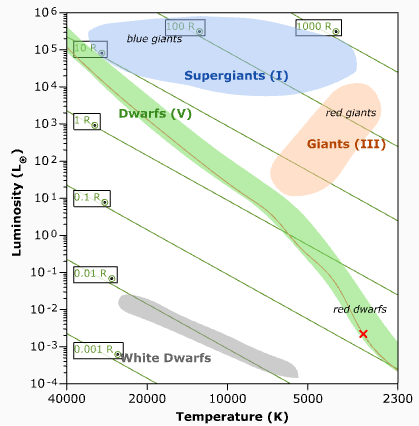Crest

Crest as seen from space
Mass |
2.86272E29 kg (0.143 M☉) |
|---|---|
Radius |
1.18269E5 km (0.17 R☉) |
Luminosity |
0.0022 L☉ |
Temperature |
3068 K |
Semi-Major Axis |
297 AU |
|---|---|
Inclination |
-0.3° |
Longitude of Ascending Node |
1° |
Eccentricity |
0.2 |
Argument of Periapsis |
256° |
Period |
3933 y, 8 M, 24 d |
Crest is a M-type red dwarf star, which is gravitationally bound to Solakku, forming a binary star system with it. Despite its relatively close distance, Crest’s extremely low luminosity means its light is too weak by the time it reaches Solakku’s planets for it to even cast shadows. Still, it is the brightest star in the Avali night sky, appearing as a brilliant orange star. This, combined with the fact that its orbital plane is mostly alligned with that of Valaya, means it was historically often used for navigation on Avalon.
Crest’s gravitational influence is responsible for the lack of outer dwarf planets in the Solakku system, or any large clouds of debris. While Solakku does posses a thin belt of asteroids past Musoya, it is not very dense and thus cannot be compared to Sol’s Trans-Neptunian Belt or Oort Cloud. However, it is possible that a incredibly large shell of debris similar to the outer Oort Cloud exist, surrounding the whole Solakku-Crest binary at an incredibly large distance away.
Due to being a young red dwarf, Crest is a flare star, meaning it occasionally increases its energy output for very short bursts of time (usually only a few hours), which is also coupled with a strong solar wind emission, and increase of radiation output. Though the only effect this has on Avalon is the star becoming slightly brighter in the sky for a bit, Crest’s own planets experience these flares in full force. As a result, traveling into the Crest system is hazardous. Great care must be taken to protect crew from the flare emissions, and predict them accurately. The day sides of all of the planets in the system are also bad spots to stay on for too long, without special precautions.
`
I once asked someone a lot more knowledgable about stellar evolution about how strong these flares could get, phrasing my question as "On a scale of a tiny radioactive sample from a lab to the Chernobyl reactor exploding right next to me, how bad is the radiation increase?", and the answer was a simple "yes".
`

Crest in the Hertzsprung-Russell Diagram